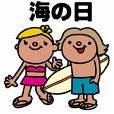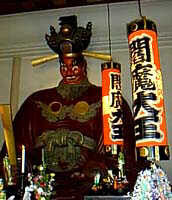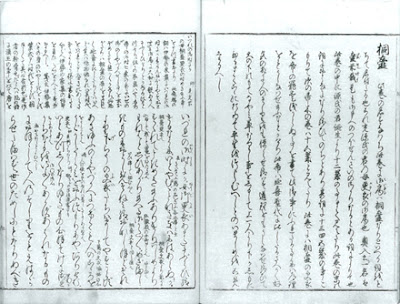:::::::::::::::::::::::::::::::::::::::::::::::::::::::::::::::::::::::::::::::::::::::::::::::::::
Benkei Festival (Benkei matsuri )
***** Location: Tanabe, Japan
***** Season: Late Autumn
***** Category: Observance
*****************************
Explanation
Benkei Matsuri 弁慶まつり Benkei Festival
first sunday in october

A parade through the town of Tanabe, with his love Tamamushi Gozen 玉虫御前 following him, and later the dynamic dance of Benkei is one of the highlights of the festival.
Every year another young man from the village is choosen to perform the dance, now in the 24th generation.

at shrine Tokei Jinja
闘けい神社 / 闘鶏神社 (とうけいじんじゃ)
Cockfight Shrine
It used to be called 新熊野鶏合大権現.
.................................................................................
quote
Tokei Jinja History
Tokei-jinja Shrine was established in 419 A.D and derives from Kumano Hongu Taisha.
In the times of abdicated Emperor Shirakawa (1053-1129), the Kumano deities were enshrined in Tokei-jinja Shrine. Many imperial and aristocratic pilgrims paid homage here praying for safe passage into the realm of Kumano. Because the Kumano deities were manifested in Tokei-jinja Shrine, some pilgrims didn’t make the voyage into the heart of Kumano, but prayed here, subsequently worshipping the three shrines of Kumano Sanzan from afar.

In the “Tales of Heike”the Kumano Betto Tanzo 熊野別当湛増 (or steward of the Kumano shrines,
who is said to be the father of Benkei)
turned to the gods to decide which side to join forces with during the historic sea battle of “Dan-no-ura” (1185) between the Heike and Genji clans by holding a divinatory cockfight here with a white and a red cock. The white cock, representing the Genji, won the fight.
By the order of the gods the Kumano Navy (Kumano suigun熊野水軍) supported the Genji, turning the tide of the war, and destroying the Heike. During the shrine consolidations that took place in the Meiji era (1868-1912) this shrine was re-named “Tokei-jinja” or “cockfighting shrine” because of this event.
During the peak of the Kumano pilgrimage, Tanabe was an important junction and prospered as the entrance to the Kumano region. The city was a key location for both land and ocean transportation routes. People gathered in Tanabe before continuing onto the Kumano Sanzan or the Saigoku pilgrimage (33 Kannon pilgrimage of Western Japan).
source : www.tb-kumano.jp
.................................................................................

Nearby is also a shrine in his honor
Benkei Jinja, Benkei Yashiro 弁慶神社
. . . CLICK here for Photos !
and a pine in his honor
Benkei matsu 弁慶松
. . . CLICK here for Photos !
and a stone where he sat down
Benkei Koshikake Iwa 弁慶腰掛岩
. . . CLICK here for Photos !
and a few more things in memory of Benkei in his youth.
The whole town of Tanabe is full of Benkei artifacts.
.................................................................................
紀州鈴屋 「弁慶の釜」 Benkei no kama

A Wafer in the form of a small pot, the one that Benkei has his first bath as a baby.
The wafer comes in two parts, with a lid of a slightly different falvor with yuzu citrons.
The flavor of the pot filling is taken from the famous plums of Kishu.
In a nearby museum in Tanabe you can see the real pot 弁慶産湯の釜.
. . . CLICK here for Photos !

A dish made from local chicken, called
弁鶏(べんけい) BenKEI
in a pun with the sound of the name, written with the Chinese character KEI for chicken.
. . . CLICK here for Ben-KEI Photos !

There is also a famous ricewine, 酒
Benkei no Sato 弁慶の里, produced in Tanabe town.

sake barrels offered at the Benkei Shrine
:::::::::::::::::::::::::::::::::::::::::::::::::::::::::::::::::::::::::::::::::::::::::::::::::::
Tanabe matsuri 田辺祭り Tanabe Festival
Every year on July 24th and 25th, the annual summer festival of Tokei-jinja Shrine is held. The year 2009 marked the 450th anniversary of the Tanabe Festival. In 1969 this festival, which is filled with much pomp and circumstance, was designated as an intangible folklore cultural asset of Wakayama prefecture.
Yoinomiya: Festival Eve (July 24)
Hon-matsuri: Festival Day (July 25)
At 4:30 the Akatsuki-no-Saiten ritual of dawn begins at Tokei-jinja Shrine.
Kasahoko Floats
In the evening of the 25th, there is
Yabusame, horseback archery demonstration
During the Tanabe Festival you can see eight “Kasahoko" from the eight traditional districts related to the old castle and merchant towns of Tanabe. Locals call the Kasahokos “Okasa”. “Kasahoko” is a sort of “Dashi” which broadly means an attraction of an event. But specifically speaking, Dashi in a Japanese festival performs a sacred role. The Kanji characters for Dashi are 山車, which mean “mountain” and “wheel” or “vehicle”. Literally Dashi are large elegant floats elaborately decorated, and are related to the local history and Kami deities of the area. Dashi are pulled and pushed through the city by many men to pay homage at shrines and sacred sites. There is a great diversity of Dashi, with as many variations of Dashi as there are festivals in Japan.
Look at more photos of the festival HERE :
source : www.tb-kumano.jp
*****************************
Worldwide use
*****************************
Things found on the way
. Senteisai festival 先帝祭 and Antoku Tenno 安徳天皇
Shimonoseki
*****************************
HAIKU
闘鶏や兵ものどもの夢は今
tookei ya tsuwamonodomo no yume wa ima
this cockfight -
the dreams of ancient warriors
still alive
Gabi Greve, Autumn 2010
:::::::::::::::::::::::::::::::::::::::::::::::::::::::::::::::::::::::::::::::::::::::::::::::::::

One of the most famous tsuwamono (Hercules) is maybe super-strong Musashibo Benkei 武蔵坊弁慶, the monk-soldier who accompanied Yoshitsune during his whole life.
. Brave Warrior (tsuwamono) and Haiku
*****************************
Related words
From ancient times to the Middle Ages, the faith instilled by the Kumano Sanzan of Hongu, Shingu and Nachi was at a peak and many believers ranging from emperors and nobles to the commoner made their pilgrimages to Kumano.
Now a World Heritage Site.
***** . The ancient Kumano Pilgrims Road
Kumano Kodoo, Kumano Kodō (熊野古道) and Haiku
***** . yabusame 流鏑馬(やぶさめ)Yabusame
and its related kigo
***** . Tori awase 鶏合 (とりあわせ) Ritual Cock Fighting
Hahnenkampf, and its related kigo
BACK : Top of this Saijiki
[ . BACK to WORLDKIGO . TOP . ]
:::::::::::::::::::::::::::::::::::::::::::::::::::::::::::::::::::::::::::::::::::::::::::::::::::::















































